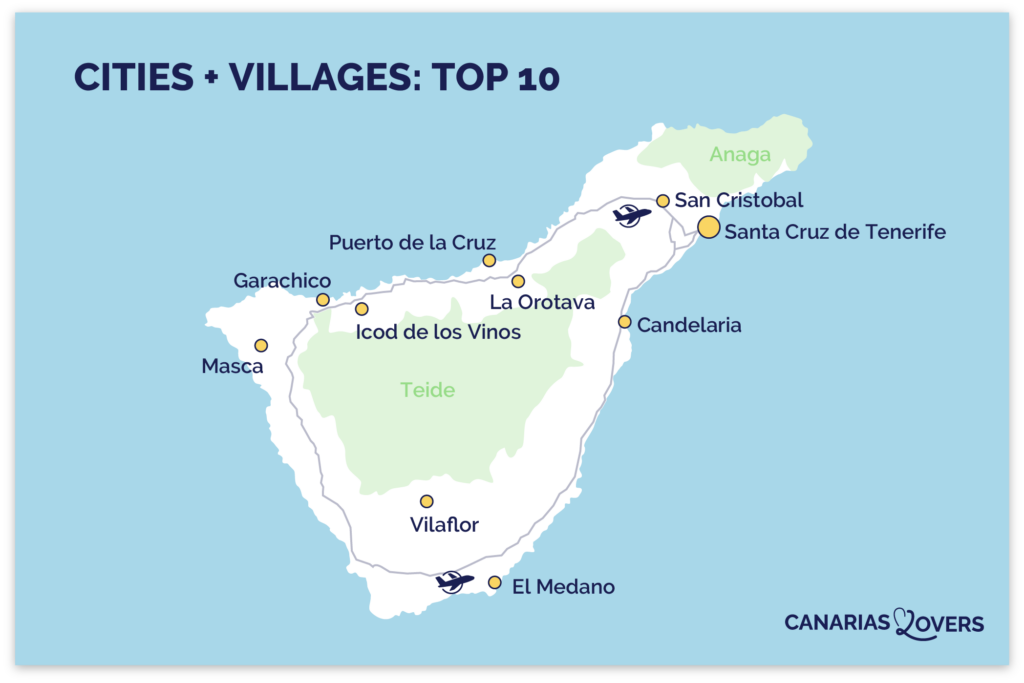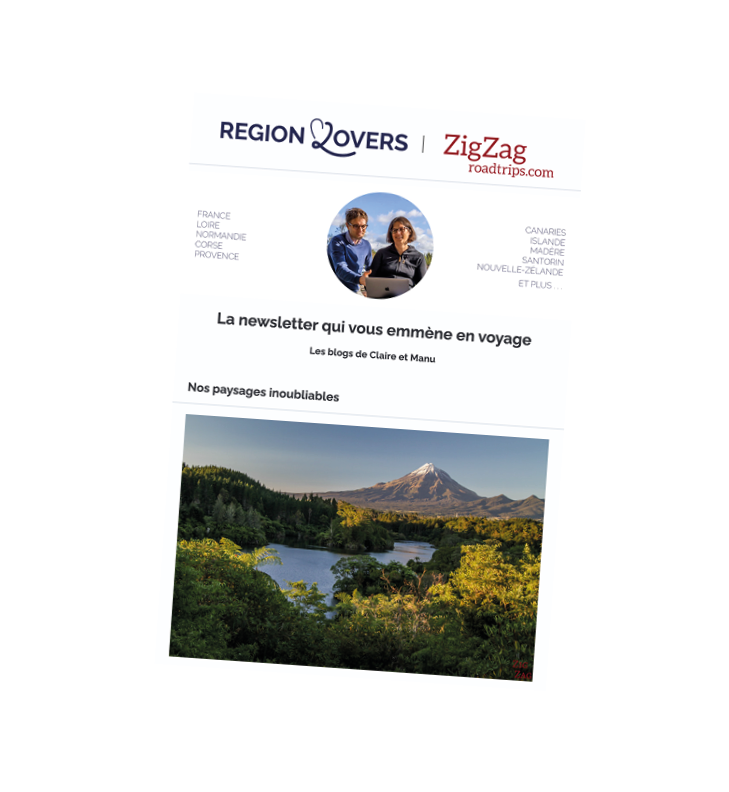Travelling to Tenerife: volcanic landscapes, mesmerizing forests, sandy beaches, charming towns… The island offers unforgettable vacations!
But to make sure your trip to Tenerife is a success, it’s best to have a few things in mind and be well prepared.
On this page, we’ve put together all our advice to help you make the right choices and find the trip that’s right for you: when, how, where…

This opinion is completely independent, based on our experiences. We visited the region anonymously, making our own choices and paying our bills in full.
Content
The essentials for a successful trip to Tenerife
If you don’t want to read the whole article, here’s a summary of our answers. But you’ll find more detailed information in each section below.
When to go
Tenerife’s temperatures are pleasant all year round. The high season is between June and September, the vacation season in Europe. May, September and October are often excellent months to make the most of the island.
How long
We recommend a stay of between 7 and 10 days to discover the whole island, or 2 weeks to get the most out of it.
More perspectives in our article on how many days.

Where to go in Tenerife: best hotels
Our favorite towns to stay in are:
- Costa Adeje in the south for beaches – see our selection of the best hotels
- La Laguna for a more cultural experience, but far from the beaches – see our selection of the best hotels.
- Puerto de la Cruz in the north – see our selection of the best hotels
But the island is pretty big, so if you’re staying for 10 days, to cut down on driving time, you can spend 5 days in the south and 5 in the north.
And our favorite hotels are:
- Boutique-hotel: La Laguna Gran Hotel in La Laguna – Check photos and availability
- 5 stars: Royal Hideaway Corales Beach in Costa Adeje – Check photos and availability
- All-inclusive resort: Hotel JOIA Salomé by Iberostar in Costa Adeje – Check photos and availability
- Family: GF Victoria in Costa Adeje – Check photos and availability

A simplified map for orientation
Here’s a map to help you understand the essential, well-known features of Tenerife:
- The capital, Santa Cruz de Tenerife
- The most beautiful towns and villages
- North and south airport
- The Teide volcano in the center
- Anaga rural park in the northeast

How to get around
It may be tempting to stay in the hotels with their superb swimming pools and all amenities, but we recommend renting a car to discover the island’s magnificent landscapes. It’s really easy to drive – see the car offers on our favorite platform.
Our top 4 things to do
We love many places in Tenerife. Our top 3 is:
- Explore Teide National Park
- Take a boat trip to see whales and dolphins
- Discover the Anaga massif and its primary forest
- Visit a historic town like La Laguna or La Orotava
More suggestions in our article on the best attractions in Tenerife.

Not to worry
Travelling to Tenerife is easy enough.
Just remember to protect yourself from the sun and check the sea conditions before jumping in.
A LITTLE MORE patience
All the photos, maps, information and addresses you need to make your stay in the Canaries a success will soon be available in a single ebook!
If you’d like to be notified when our guide to the Canaries is published, please subscribe:

Tip 1. When to go to Tenerife
Tenerife is open all year round.
It’s an island with very little rainfall, even in winter.
So there’s a good chance you’ll enjoy sunny weather whatever the month.
Depending on what you’re looking for:
- For guaranteed, substantial heat: June to September
- For swimming: July to October
- For hiking and exploring: April, May, September and October
- For winter sun: December to March (but the sea water is much lower).

But here are a few things you should know:
Crowd
The seaside resorts are very popular. And the main roads are always crowded.
But as soon as you get away from the tourist spots, it’s much quieter.
The island also gets quite a few tourists in winter, as people seek out the sun!
Weather
Temperatures become very high in summer, are very pleasant in the intervening months and are always pleasant in winter. You’ll be able to walk around in a t-shirt during the day in winter, but you’ll just need a jacket for the evenings.
Swimming
July to October are the best months to swim in the warm waters, once it has had time to warm up.
More detailed information in our article: When to go to Tenerife (coming soon).

Tip 2. How long to stay
The island is quite large, with a circular road that allows you to move quickly around a good part of the island.
From Santa Cruz in the north to Costa Adeje in the south, it’s a 50-minute to 1-hour drive by expressway.
Here’s a map with the main driving times to give you an idea:

If you’re planning to enjoy the beach and the hotel, plan ahead.
However, if you want to discover the island’s most iconic sites, 7 days is enough (without a beach day).
And if you want to see more of what the island has to offer, we recommend 10 days to 2 weeks.
More details in our article on how long to stay.
Tips 3 to 6. How to get to Tenerife
3. Where is Tenerife? In which country?
Tenerife is an island in the Canary Islands.
It is part of political Europe, being a territory of Spain.
In terms of geography, it lies to the west of the Canary Islands, not far from the Sahara coast of Africa.
4. Flights to Tenerife
Tenerife has two airports:
- Tenerife Sud (TFS) – the main airport for international flights
- Tenerife Nord (TFN) – mainly for domestic flights
There are direct flights from many major European cities: Paris, London, Berlin, Hamburg, Frankfurt, Madrid, Barcelona, Amsterdam, Zurich, Milan… Ryanair offers many low-cost flights to Tenerife.

5. Ferry to Tenerife
You can also reach Tenerife from the other Canary Islands or from Cadiz in mainland Spain.
The main port is Santa Cruz de Tenerife.
6. Visa and identity papers for Tenerife
Tenerife is part of Spain, and therefore within the Schengen area.
If you are one of them, you don’t need a visa. Otherwise, you need a Schengen Visa.
For all of them, you must have a valid identity document to circulate on the territory, and also to take the plane or the ferry.

Tips 7 to 10. Where to go in Tenerife
7. Where to stay in Tenerife
There’s absolutely no better place to stay in Tenerife. It all depends on what you’re looking for. Here are some of our recommendations.
Costa Adeje
Costa Adeje is a modern, elegant seaside resort. Here you’ll find beautiful beaches, a pleasant seafront promenade and numerous restaurants. This is where you’ll find the highest concentration of 5-star hotels on the island, especially around Playa el Duque.
See our selection of the best hotels.
Puerto de la Cruz
Puerto de la Cruz is a charming town that combines history and modernity. It offers an excellent balance of tourist attractions, with magnificent gardens.
See our selection of the best hotels.
San Cristóbal de La Laguna
If you’re looking for a more authentic and cultural experience, La Laguna is an excellent choice. This UNESCO World Heritage city boasts remarkable colonial architecture and a lively student atmosphere.
However, no direct access to the beach.
See our selection of the best hotels.
See more ideas in our article: Where to stay in Tenerife (coming soon).

8. Best hotels in Tenerife
If the hotel is more important to you than the location, here are our best of, by style:
- Best 5-star hotels
- Best boutique hotels (coming soon)
- Best hotels for families (coming soon)
- Best adults-only hotels (coming soon)

9. Single or multiple units?
It’s a 1-hour drive from the north to the south of the island.
So you can explore the whole island from a single hotel.
But if you’re staying for more than a week, we think it’s worth staying half in the north and half in the south, so you can experience the parties and restaurants in two different cities.
10. Always check parking conditions
Parking can be a problem in many cities and in some tourist areas.
If you’re renting a car, check your hotel’s parking conditions.
And for the most touristy places, plan to visit them early to make things easier (for example, Teide or Masca).
Subscribe to our Newsletter
- Get away from it all with Region Lovers’ beautiful destinations!
- Once a month
- Advertising-free
11 à 14. Getting around Tenerife
Here are the 4 options for getting around the island of Tenerife. Of course, if you’re staying in the hotel, all you have to do is take a cab or bus from the airport.

11. Rent a car
Our preferred option is to rent a car. Prices are reasonable for an island and driving is easy. The only difficulties are some narrower mountain roads and some very, very steep roads on the north-western tip.
Don’t take a car that’s too wide, or a smaller car with a limited engine if you’re planning to explore everything.
The platform we personally use (since we discovered them) is Discovercars. See their current car rental offers in Tenerife.
As soon as we decide on a destination and dates, we look at their offers, which are often among the best. It is one of the highest rated comparison sites in the market.
Or read all our car rental tips.
12. Excursions
From most hotels you can also find numerous excursions to explore certain parts of the island: the mountains, the dunes, the island of Lobos, the Ajuy caves…
See all offers on our preferred platform: Getyourguide
Or read our guide to the best excursions (coming soon)

13. Cabs
If you’re not traveling too far from your hotel, you can also choose to visit a place by cab. But don’t forget to book your return trip.
They also offer tours.
14. Public transport
You can find buses that connect all Gran Canaria’s major towns with regular services. It won’t be possible to get to more remote areas. See routes.
There’s also a tramway between Santa Cruz and La Laguna.

15 to 17 – Food and beverages
15. Is tap water safe to drink in Tenerife?
Yes, you can drink tap water. There’s no danger.
Just be aware that Tenerife receives little rain. So tap water comes from desalinated seawater. So it doesn’t taste the best, or the taste we’re used to. Most people drink bottled mineral water.
16. Type of food
Tenerife is a tourist island, so you’ll find everything:
- Traditional Canarian cuisine
- Mediterranean cuisine, tapas
- Italian restaurants
- Indian restaurants
- Chinese restaurants
- Seafood and fresh fish
- …
Gran Canaria has an interesting range of gourmet restaurants. Some even try to combine traditional food with modern gastronomic techniques.
See our favorite restaurants in Tenerife (coming soon).
Please note that the bread placed on the table is subject to a charge if you touch it.
And water, even in carafes, is not free.

17. Tip
Tipping is not obligatory in Tenerife.
It’s a good idea to round up if you’re paying cash, or to leave a few euros if you’re really satisfied with the service. It’s a voluntary act, to reward quality (5-10%).
18 to 21 – Planning your vacation in Tenerife
18. Suitcase – what to take to Tenerife
All year round, pack light summer clothes.
And if you’re traveling during the winter months, add a small jacket for evenings or potentially cloudy days.
Bring warm clothing if you climb to the very top of Mount Teide.
Don’t forget your bathing suit and beach towel, and good walking shoes if you’re planning a hike.

19. Sun protection
Beware, the sun can be brutal.
Don’t take any risks, protect yourself with sunscreen, a hat and sunglasses.
And wear even more protective gear when climbing to higher altitudes in Teide National Park.
20. Language
Tenerife is in Spain. The language is Spanish. But as it’s a very touristy island, almost everyone speaks English. We also met a lot of teams who also spoke German and French.
In Tenerife you’ll also often find teams who speak Dutch, Swedish and Norwegian. And some restaurants even have adapted menus, but not all (fewer than in Gran Canaria).
21. Power strip and adapter
- Type C/F sockets (European standard)
- Voltage: 230V
- Frequency: 50Hz
- Don’t forget your adapter, if necessary!

22 to 25 – Safety when travelling to Tenerife
22. Security
Gran Canaria is a pretty safe island.
Like all tourist destinations, there can be a certain amount of theft and pickpocketing in tourist areas. Don’t leave anything visible in the car.
See our article on safety (coming soon).
Be especially careful of waves in natural pools. Check the tide times.
23. Insurance
If you are a resident of the European Union, your national medical cover also applies. Don’t forget to ask for your European medical insurance card to make the process easier.
If you are coming from outside the EU, remember to take out insurance.
24. What to do in an emergency
- European emergency number: 112 – Multilingual operators available
- Policy: 091
- Fire department: 080

25. Using a VPN
As everywhere else, you run a risk when using shared wifi in hotels.
We know, because we had a bad experience in a Paris hotel.
We now systematically use a VPN to protect our data, especially banking data.
See what our favorite VPN has to offer.
Must-see things to do in Tenerife
We share all our favorite places on this site in our article on the best attractions in Tenerife. Here’s a summary:
- Teide National Park and its volcanic landscapes
- The cliffs and forests of Anaga
- The architecture of San Cristóbal de La Laguna
- Historic towns (Candelaria, La Orotava, Garachico)
- Whale and dolphin watching
- Charming villages (Masca, Vilaflor)
- Magnificent beaches (Teresitas, El Medano)
- Hiking (Barranco del Inferno, Mount Teide…)
- The impressive Los Gigantes cliffs
- Natural pools
- Botanical gardens
- Nautical activities
- Stargazing
- An excursion to La Gomera
And there’s plenty of fun to be had too:
HAVE FUN IN TENERIFE: activities

Itineraries in Tenerife
See all our itinerary suggestions (we’ll be writing them up soon):
- 3 days
- 4 days
- 5 days
- 1 week
- 10 days
OUR TIPS TO RENT A CAR IN Tenerife
- Compare prices on our preferred platform: DiscoverCars – one of the best rated sites.
- If you’re planning to explore the mountains, don ‘t take the smallest cars. A more powerful engine will be more comfortable.
- But don’t take too big a car either, as some roads are narrow.
- There’s a lot of demand and it’s an island, so book early.

Travelling to Tenerife: FAQs
What is the time zone in Tenerife?
Tenerife is at the same time as London (GMT/UTC+0)
Which is better: north or south?
Both regions have their strengths:
- The north: greener, more authentic, more cultural
- The south: sunnier, beaches, tourist activities
When is the best time to see whales?
Cetaceans are present all year round, but the period from December to May generally offers the best viewing conditions.
Do I need to book the Teide cable car in advance?
Yes, especially in high season. We recommend booking several days in advance.



